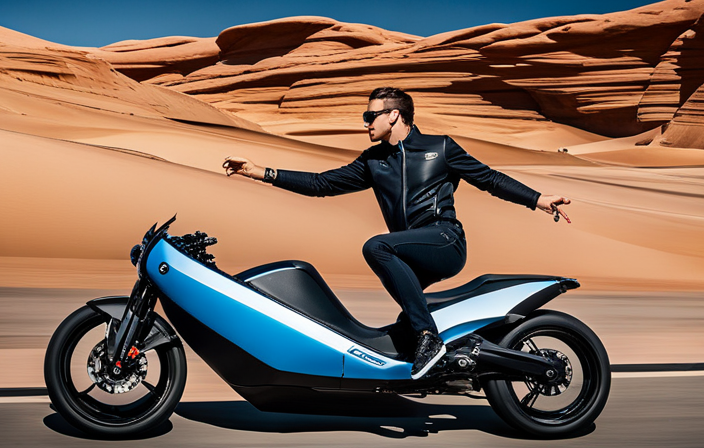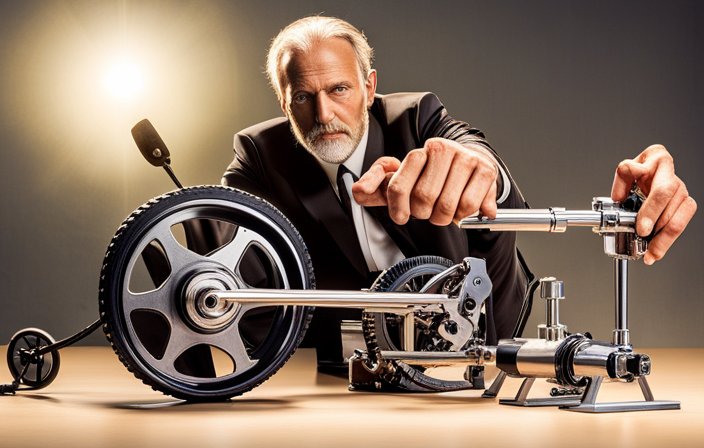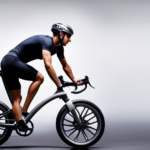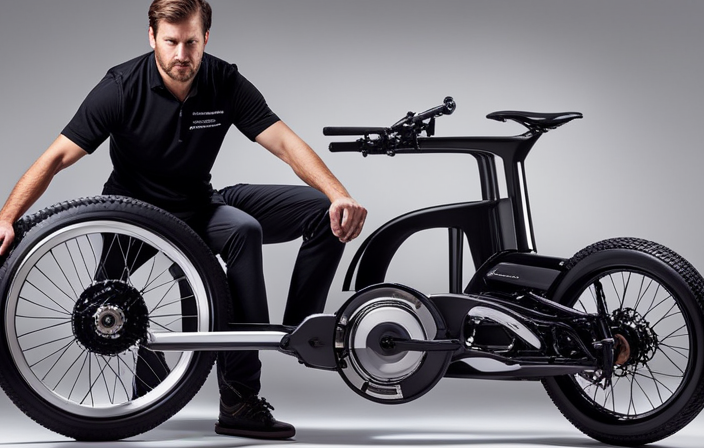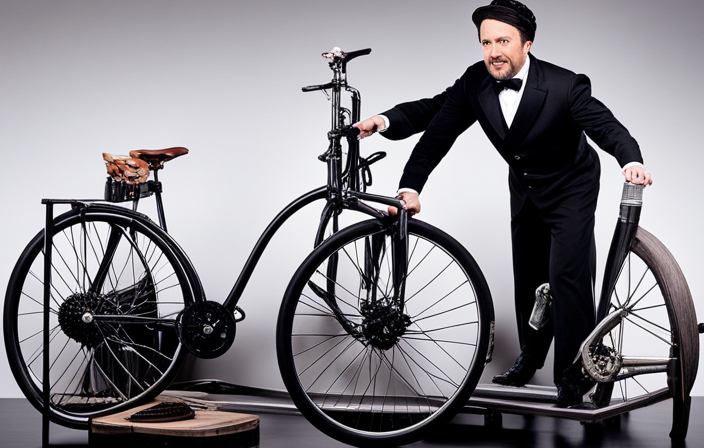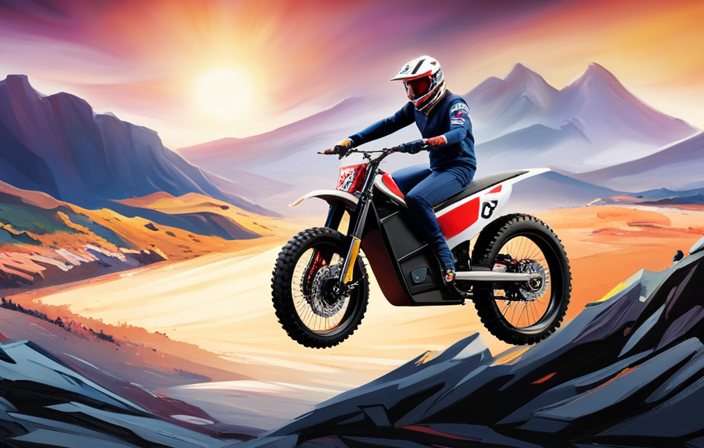I’ve always been fascinated by the potential of electric bikes and the freedom they offer. If you’re like me and want to squeeze every ounce of power out of your electric bike, you’ve come to the right place.
In this article, we’ll explore a range of techniques to boost your bike’s performance. From upgrading your battery and optimizing motor settings to reducing weight and improving aerodynamics, these tips will help you unleash the full potential of your electric bike.
Let’s dive in and unlock the power!
Key Takeaways
- Install a regenerative braking system to convert wasted energy into electrical energy, increasing efficiency and extending range.
- Choose high-quality, low-resistance tires based on rolling resistance rating to maximize efficiency and extend range.
- Maintain optimal performance and efficiency by ensuring proper chain tension and lubrication.
- Optimize riding style and positioning by adjusting pedal assist level, maintaining smooth pedaling motion, reducing wind resistance, and improving body positioning to reduce drag.
Upgrade to a more powerful battery
If you want to get more power out of your electric bike, you should definitely consider upgrading to a more powerful battery. Upgrading the battery can significantly increase the performance and range of your electric bike.
One of the key advantages of upgrading to a more powerful battery is the longevity it offers. Upgraded batteries are designed to have a longer lifespan compared to standard batteries, which means you can enjoy more rides without worrying about frequent replacements.
Additionally, while the cost of upgrading your battery may seem high initially, it can be cost-effective in the long run. The increased power and range you get from the upgraded battery can save you money on fuel costs or transportation expenses.
To further optimize your bike’s performance, you should also consider optimizing your bike’s motor settings.
Optimize your bike’s motor settings
To optimize your bike’s motor settings, you should adjust the speed and torque levels to achieve better performance. By optimizing these settings, you can maximize the motor power and get the most out of your electric bike.
Start by optimizing the battery to ensure it is fully charged and functioning at its best. This will provide the necessary power for your motor to perform optimally.
Next, adjust the speed settings according to your riding preferences and the terrain you will be cycling on. Increasing the torque levels will give you more power when climbing hills or accelerating quickly. By finding the right balance between speed and torque, you can optimize your bike’s motor settings and enjoy a more efficient and powerful ride.
To further enhance your electric bike experience, let’s explore how to use pedal-assist mode effectively.
Use pedal-assist mode effectively
To use pedal-assist mode effectively, simply engage the mode and let it complement your pedaling effort for a smoother and more efficient ride.
Pedal-assist mode is a feature found in many electric bikes that provides assistance while you pedal. It is designed to enhance your riding experience by reducing the strain on your legs and allowing you to maintain a consistent speed.
By using pedal assist techniques, such as adjusting the assist level or cadence sensor sensitivity, you can customize the level of assistance provided by the motor.
The benefits of using pedal assist mode include extending the range of your electric bike, reducing fatigue during long rides, and making it easier to conquer hills.
Transitioning into the subsequent section about ‘reduce weight on the bike’, focusing on optimizing your bike’s weight can further enhance your riding experience.
Reduce weight on the bike
Reducing the weight on your bike can improve your riding experience. By using lightweight materials, you can significantly decrease the overall weight of your bike, making it easier to handle and maneuver. Additionally, optimizing the battery capacity can help reduce weight by using more efficient and compact battery systems. Here are three ways to reduce weight on your bike:
-
Use carbon fiber components: Carbon fiber is an extremely lightweight and strong material that can replace heavier metal parts, such as the frame, handlebars, or seat post.
-
Choose lighter accessories: Replace heavy accessories like racks, fenders, or lights with lighter alternatives made from lightweight materials.
-
Streamline your gear: Carry only essential items and minimize unnecessary weight, such as extra tools or excessive water.
By reducing the weight on your bike, you can enhance your riding performance and efficiency.
One additional way to optimize your electric bike’s performance is by ensuring your tires are inflated to the recommended pressure. This will improve grip, stability, and overall riding experience.
Inflate tires to the recommended pressure
Make sure you check the recommended pressure and inflate your tires accordingly for optimal performance. Increasing the tire pressure can have a significant impact on your electric bike’s power output. Higher tire pressure reduces rolling resistance, allowing for smoother and more efficient rides. Additionally, choosing wider tires can also improve power transfer to the road surface. Wider tires have a larger contact patch, increasing traction and reducing energy loss. To help you visualize the difference, here is a comparison of tire widths and their corresponding benefits:
| Tire Width (inches) | Benefits |
|---|---|
| 2.0 | Improved stability and control |
| 2.5 | Enhanced traction on rough surfaces |
| 3.0 | Maximum grip and comfort |
Improve aerodynamics with a fairing or streamlined accessories
After ensuring that my tires are properly inflated, I realized that there are more ways I can improve the power of my electric bike.
One effective method is to improve its aerodynamics by adding a fairing or streamlined accessories. By doing so, I can reduce wind resistance and make my bike more efficient.
A fairing is a protective shield that covers the front part of the bike, reducing drag caused by wind. Streamlined accessories, such as aero handlebars and aero helmets, also help to minimize air resistance. These modifications not only improve stability but also make the bike more aerodynamic, allowing me to ride faster and with less effort.
However, there is another crucial component that can further enhance the performance of my electric bike – installing a more efficient motor controller.
Install a more efficient motor controller
One way to enhance the performance of my electric bike is by installing a more efficient motor controller. The motor controller is responsible for regulating the flow of electricity from the battery to the motor, and a more efficient controller can improve the overall efficiency and power output of the bike.
When considering a motor controller upgrade, it’s important to look for options that offer higher efficiency ratings. Some upgrade options include controllers with advanced pulse width modulation (PWM) technology, which can provide smoother power delivery and better control over the motor’s performance. Additionally, controllers with higher voltage and current ratings can handle more power, resulting in increased performance.
By installing a more efficient motor controller, I can maximize the power and efficiency of my electric bike.
This improvement sets the foundation for the subsequent section, which explores the addition of a regenerative braking system.
Add a regenerative braking system
To improve your electric bike’s efficiency even further, consider adding a regenerative braking system.
Regenerative braking benefits your bike by converting the energy that is typically wasted during braking into electrical energy, which can then be stored in the battery for later use.
Installing a regenerative braking system on your electric bike is relatively straightforward.
First, you will need to purchase a regenerative braking kit, which typically includes a motor controller, a brake lever with a built-in switch, and a wiring harness.
Next, you will need to locate the existing brake calipers and remove them.
Once the old calipers are removed, you can install the new regenerative braking system by attaching the motor controller, connecting the wiring harness, and mounting the new brake lever.
With a regenerative braking system in place, you can maximize your electric bike’s efficiency and extend its range.
To further enhance your bike’s performance, consider using high-quality, low-resistance tires.
Use high-quality, low-resistance tires
When choosing tires for your electric bike, opt for high-quality, low-resistance ones to maximize efficiency and extend range. High-quality tires not only improve handling but also increase traction, ensuring a smoother and safer ride. Low-resistance tires reduce rolling resistance, allowing you to pedal more easily and conserve battery power. To help you make an informed decision, here is a comparison table of some popular high-quality, low-resistance tires:
| Tire Brand | Tire Model | Rolling Resistance Rating |
|---|---|---|
| Brand A | Model X | Low |
| Brand B | Model Y | Medium |
| Brand C | Model Z | Low |
Maintain proper chain tension and lubrication
To ensure optimal performance and efficiency of your electric bike, it is crucial to maintain proper chain tension and lubrication. Here are four key steps to follow for proper chain maintenance:
-
Check chain tension: Use a chain tension gauge or simply push down on the chain to ensure it has the right amount of tension. Too loose or too tight can lead to decreased power transfer and increased wear.
-
Clean the chain: Regularly clean the chain with a degreaser to remove dirt and debris that can cause friction and reduce efficiency.
-
Choose the right lubricant: Using a high-quality lubricant specifically designed for bicycle chains is essential. Apply a thin layer evenly and wipe off any excess to avoid attracting dirt.
-
Regularly inspect and replace: Look for signs of wear, such as elongation or rust, and replace the chain as needed to maintain optimal power transmission.
By maintaining proper chain tension and lubrication, you can maximize power transfer and ensure a smooth and efficient ride.
Now, let’s explore how to adjust your riding style for maximum efficiency.
Adjust your riding style for maximum efficiency
Adjusting your riding style can help you achieve maximum efficiency on your e-bike. By implementing proper riding techniques and maintaining your battery, you can optimize your bike’s performance and extend its range. Here are some key riding techniques and battery maintenance tips to consider:
| Riding Technique | Description |
|---|---|
| Pedal Assist Level | Adjust the level of pedal assist according to the terrain and your desired effort level. Higher levels consume more battery power. |
| Smooth Pedaling | Maintain a steady and consistent pedaling motion to reduce strain on the motor and optimize battery usage. |
| Efficient Gearing | Select the appropriate gear for the terrain to ensure an efficient transfer of power from the motor to the wheels. |
| Aerodynamic Positioning | Reduce wind resistance by tucking in your elbows and knees, allowing for smoother and faster rides. |
Reduce drag by tucking in your elbows and knees
By tucking in your elbows and knees, you can significantly reduce drag and experience a smoother and faster ride on your e-bike. Here are some key techniques and considerations for optimizing your body positioning and minimizing wind resistance:
- Lowering the body: Lower your torso closer to the handlebars, reducing the frontal area exposed to the wind.
- Bending your elbows: Keep your elbows tucked in and close to your body, minimizing the air turbulence caused by extended arms.
- Aerodynamic clothing: Choose tight-fitting clothing made from materials specifically designed to reduce drag, like lycra or spandex.
Body positioning for better aerodynamics and selecting appropriate clothing play crucial roles in reducing drag and increasing your e-bike’s efficiency.
To further enhance your ride, the next section will delve into the benefits of opting for a lighter frame or components.
Opt for a lighter frame or components
Choosing a lighter frame or components can greatly improve the performance and efficiency of your e-bike. By opting for lightweight materials, such as carbon fiber or aluminum, you can reduce the overall weight of your bike. This makes it easier to handle and increases its power-to-weight ratio.
A lighter frame also allows for better maneuverability, especially when navigating tight corners or climbing steep hills. Additionally, investing in a suspension system can further enhance the ride quality and control of your e-bike. A good suspension system absorbs shocks and vibrations, ensuring a smoother and more comfortable ride. It also helps maintain traction and control, especially when riding on rough terrains.
Upgrading to a more efficient charger will be the next step to boost the power of your e-bike without compromising its battery life.
Upgrade to a more efficient charger
After considering the benefits of a lighter frame or components, it’s time to explore another way to get more power out of your electric bike. Upgrading to a more efficient charger is a crucial step in maximizing your bike’s performance. Here are three reasons why you should consider this upgrade:
-
Faster Charging: An upgraded charger adapter can significantly reduce charging time, allowing you to spend less time waiting and more time riding.
-
Improved Battery Life: A more efficient charger ensures that your battery is charged optimally, which can help extend its overall lifespan.
-
Enhanced Power Output: Upgrading your charger can provide a higher current output, resulting in a faster and more powerful charge.
By upgrading to a more efficient charger, you’ll be able to charge your electric bike faster and unlock its full potential.
However, if you’re looking for even more extended range, consider a dual battery setup.
Consider a dual battery setup for extended range
A dual battery setup can significantly increase the range of your electric bike. By incorporating two batteries, you can effectively double the capacity of your bike’s power source. This means more miles of riding without worrying about running out of juice.
To optimize the charging of dual batteries, it is important to ensure that both batteries have similar states of charge before connecting them. This will prevent one battery from draining the other during charging. Additionally, using a charger specifically designed for dual battery charging can help balance the charging process and ensure that both batteries are charged evenly.
Frequently Asked Questions
Can I increase the power of my electric bike by upgrading to a more efficient charger?
Upgrading to a more efficient charger alone may not directly increase the power of your electric bike. However, upgrading the battery capacity and optimizing the motor performance can result in a more powerful ride.
How can adjusting my riding style improve the power output of my electric bike?
Adjusting my riding style can improve the power output of my electric bike by optimizing pedal assist settings and improving battery performance. By using the correct pedal assist level and maintaining a steady pace, I can maximize the bike’s efficiency and power.
Is it possible to extend the range of my electric bike by using a dual battery setup?
Yes, it is possible to extend the range of an electric bike by using a dual battery setup. The advantages of a dual battery setup include increased total capacity, longer riding distance, and the ability to swap batteries for continuous use.
What are some ways to reduce drag and improve aerodynamics on my electric bike?
Reducing drag on an electric bike is crucial for improving aerodynamics. Proper tire pressure is essential as it minimizes rolling resistance, while wearing aerodynamic clothing and accessories can further enhance performance by reducing wind resistance.
Will upgrading to a lighter frame or components increase the power output of my electric bike?
Upgrading to a lighter frame or components may not directly increase the power output of an electric bike. However, it can improve overall performance by reducing weight and increasing efficiency, allowing for better battery capacity and optimized motor performance.
Conclusion
In conclusion, by following these tips, you can significantly increase the power and performance of your electric bike.
Upgrading to a more powerful battery and optimizing the motor settings will provide a noticeable boost in speed and acceleration.
Utilizing pedal-assist mode effectively and reducing weight on the bike will further enhance its performance.
Inflating tires to the recommended pressure and reducing drag through proper body positioning will also contribute to a smoother and more efficient ride.
Considering a lighter frame or components and upgrading to a more efficient charger will maximize the bike’s power output.
Lastly, a dual battery setup can extend the bike’s range, allowing for longer rides.
So, take these steps to unleash the full potential of your electric bike and enjoy a thrilling and powerful ride.
